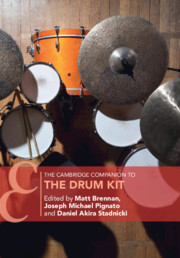Book contents
- The Cambridge Companion to the Drum Kit
- Cambridge Companions to Music
- The Cambridge Companion to the Drum Kit
- Copyright page
- Contents
- Figures
- Tables
- Music Examples
- Notes on Contributors
- Introduction
- Part I Histories of the Drum Kit
- Part II Analysing the Drum Kit in Performance
- Part III Learning, Teaching, and Leading on the Drum Kit
- 10 Studying Hybrid and Electronic Drum Kit Technologies
- 11 The Aesthetics of Timekeeping
- 12 Mentorship
- 13 Leadership
- Part IV Drumming Bodies, Meaning, and Identity
- Index
11 - The Aesthetics of Timekeeping
Creative and Technical Aspects of Learning Drum Kit
from Part III - Learning, Teaching, and Leading on the Drum Kit
Published online by Cambridge University Press: 28 May 2021
- The Cambridge Companion to the Drum Kit
- Cambridge Companions to Music
- The Cambridge Companion to the Drum Kit
- Copyright page
- Contents
- Figures
- Tables
- Music Examples
- Notes on Contributors
- Introduction
- Part I Histories of the Drum Kit
- Part II Analysing the Drum Kit in Performance
- Part III Learning, Teaching, and Leading on the Drum Kit
- 10 Studying Hybrid and Electronic Drum Kit Technologies
- 11 The Aesthetics of Timekeeping
- 12 Mentorship
- 13 Leadership
- Part IV Drumming Bodies, Meaning, and Identity
- Index
Summary
We investigate the most critical personal and musical competencies associated with successful drum kit playing. Invoking our combined teaching and performance experiences, we identify a set of interpersonal, aesthetic, and performance competencies, apply them to profiles of successful drummers, and situate them as instructional objectives for novice drummers. We analyse musical expression as personal interpretative response, isolation of temporal elements, expressive use of the drum kit, and perspectives of expert drummers. Popular music performers clearly use signature techniques and gestures to extend their personalities through performance. We review the creative competencies in this process, then focus on techniques: swing, groove, and pocket, the overlapping 'feel'-based constructs that invoke beat subdivision, beat centredness, elasticity in interpretation of time, and dynamic balance among voices on the drum kit; centredness, indicating how 'on top' of the beat drummers play; elasticity, the dynamic manipulation of time when entering or exiting phrases, playing fills, set-ups, or ensemble hits; and dynamic balance in the drum kit, the distribution of timekeeping in the hi-hat in relation to the kick and snare drum. We consider these various personal and musical competencies in the social context of ensemble music making, and make recommendations for future instruction and critical discourse.
Keywords
- Type
- Chapter
- Information
- The Cambridge Companion to the Drum Kit , pp. 156 - 167Publisher: Cambridge University PressPrint publication year: 2021



